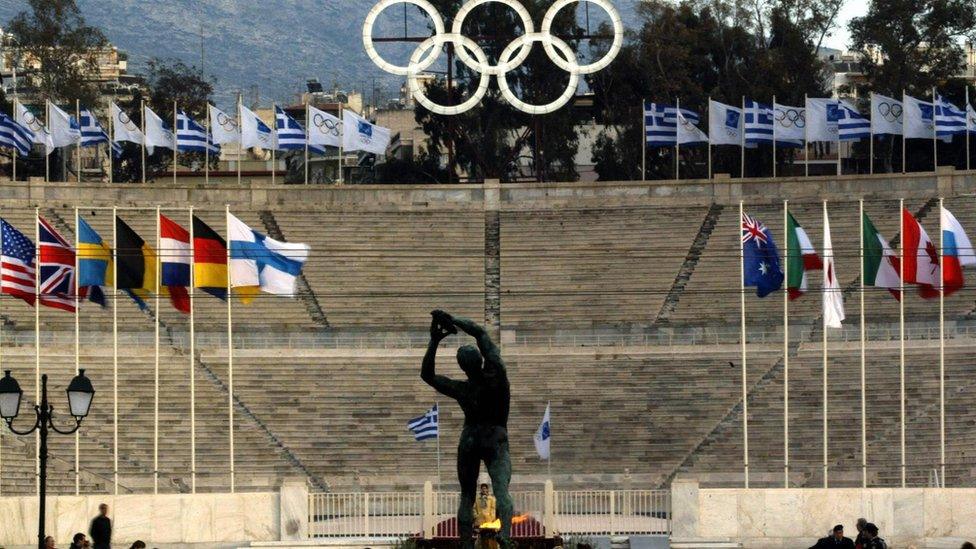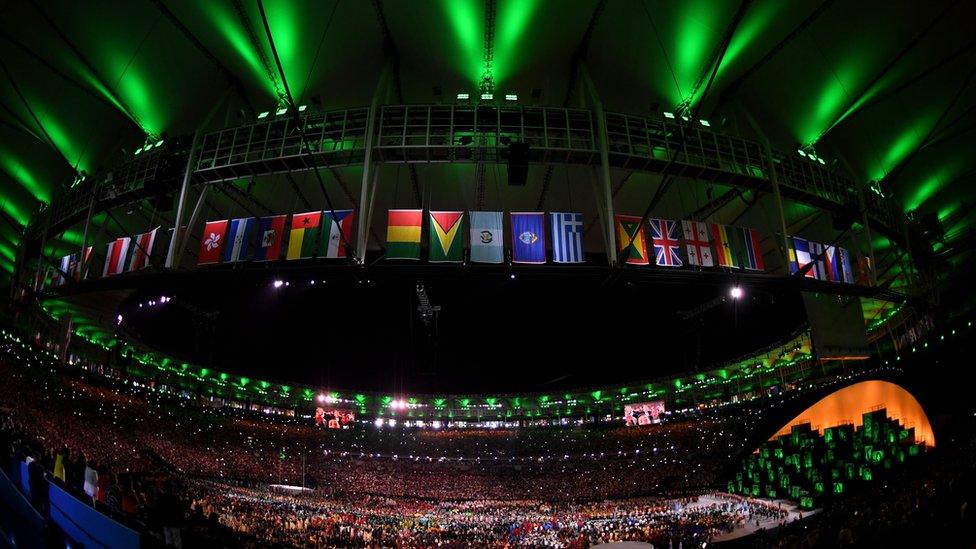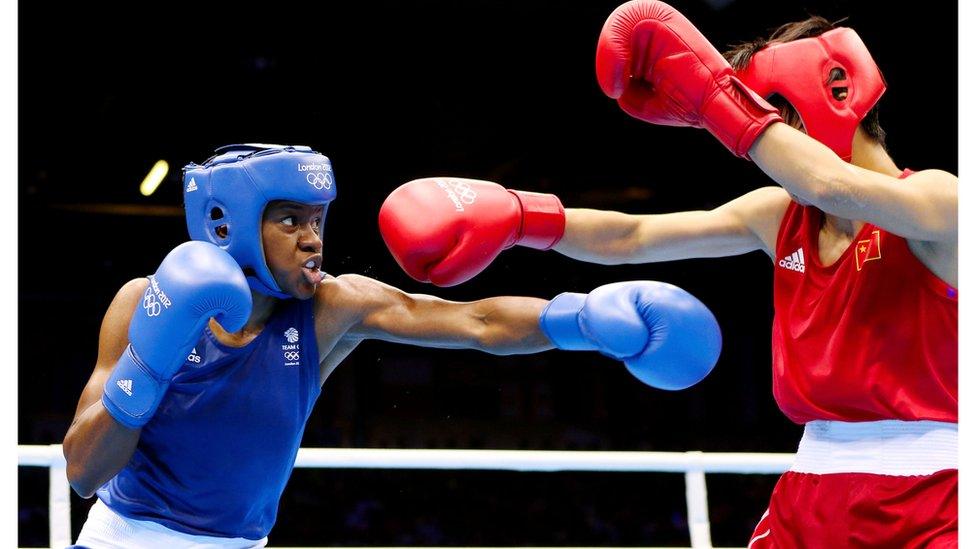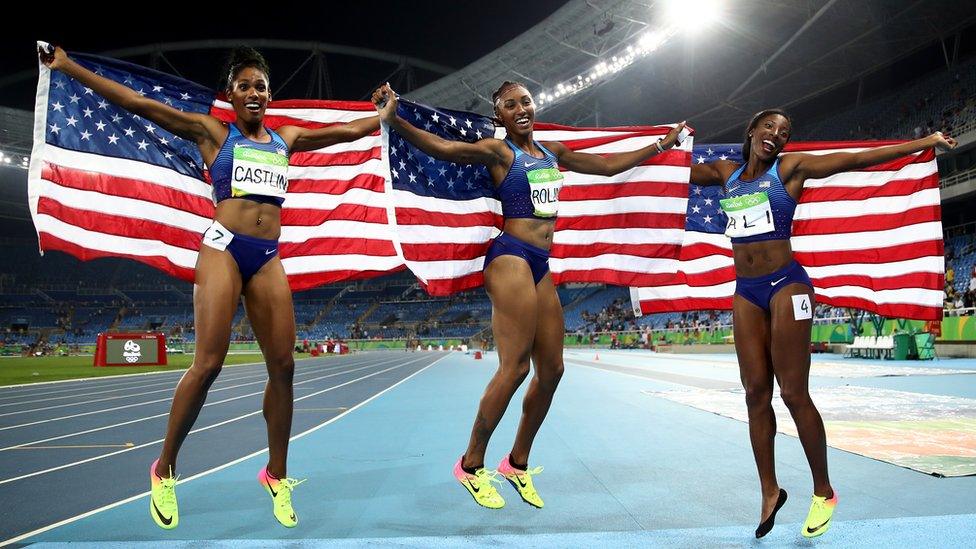100 Women: Do the Olympics have a gender gap?
- Published

There were no women athletes at the first modern Olympic Games, in 1896, because its founder, Pierre de Coubertin, thought women were "not cut out to sustain certain shocks".
More than 100 years later, Reality Check finds that women's participation in the Summer Olympics has grown, but across the Olympic movement, the gender gap still exists.
Enshrined in the International Olympic Committee (IOC), external charter is the commitment to "encourage and support the promotion of women in sport at all levels".
This would suggest the IOC no longer thinks along the lines of Pierre de Coubertin. But let's take a closer look - starting with the sportswomen who participate.

The 1896 Olympic Stadium

More women competing at Olympics
Although there were no women at the 1896 Olympic Games, 22 women competed in the second modern Games, at the turn of the century.
This was the start of a slow and bumpy rise in the number of women taking part - it took until the 1976 Montreal Games before women's participation rose above 20%.

Rio 2016 Opening ceremony
But at the 2012 London Games, for the first time ever, there was at least one woman in every delegation.
And by 2016, in Rio, 45% of the 11,238 athletes were women.
Looking ahead, there's more good news; at the 2014 Youth Olympic Games in Nanjing, China, 49% of all participants were female - a new record.

Women's v Men's events
In 1900, women competed in three mixed events - sailing, croquet and equestrian, and two women's events - tennis and golf.
Like women's participation, the number of women's events has steadily increased since then, with some notable landmarks.

Nicola Adams boxing in London 2012
In 2000, in Sydney, women's weightlifting was included, followed, four years later, by wrestling and fencing in Athens. Women boxed in 2012, in London, for the first time, and played rugby in 2016, in Rio.
Indeed, by the time of the 2016 Rio Games, there were 161 events for men, 136 for women and nine mixed, including equestrian and one sailing race. This was the closest to gender parity the Olympics has been.
Among the men-only events are the 50km race walk and canoeing, which the IOC says will change in 2020. Of course, two events discriminate against men as they are women-only - synchronised swimming and rhythmic gymnastics.

What about women in leadership roles?
While the gender gap appears to be closing for the athletes, the same is not true of the Olympic movement's leadership.
By the IOC's own admission, women's participation remains "low".
It claims some success - since 2013, more women have been appointed to the commissions that support the IOC - 38% of places are now taken up by women.
However, currently four out of 15 members of the Executive Board of the International Olympic Committee are women. That's 27%.
Of the 135 national Olympic committees who responded to an IOC survey in 2015, only 11 had a woman president. That's 8%.

Lessons from the USA's women's team

Team US at the 2016 Rio opening ceremony
The American experience would suggest a change in policy is needed to make gender equality a reality.
In 2016, in Rio, the United States won 121 medals, topping the medal table. That may not be that surprising - American athletes have dominated Olympic medal tallies for years.
But what you may not know is that the women on the team won more medals (61) than the men (55) - including more gold medals, by 27 to 19.
This was not a one-off. The same happened in 2012, in London, where US women won 13 more medals than their male counterparts.

USA women celebrate gold, silver and bronze in the 100m women's hurdles

Why do US women do so well?
American female athletes were not always so successful. In the 1972 Munich Olympics, US men won 71 medals while the women brought home only 23.
But in the same year, something else happened - legislation called Title IX was passed by Congress.
Title IX is part of the 1972 Education Amendments Act.
It prohibits gender discrimination in any educational programme that receives government funding.
The rule meant that schools and colleges must offer equal sport and athletic opportunities to both sexes.
It had an immediate effect; in 1972 fewer than 300,000 women participated in high school athletics. By 2001, that number was 2.8 million.
And Title IX is credited - by academic journals and sporting bodies alike - as the reason American women do so well at the Olympic Games, because government money and resources have been spent equally on women as on men.
While Title IX is championed as the reason behind women's sporting achievements in the US, this has not translated into women's participation in leadership positions.
A report by the Women's Sport Foundation, external suggested 80% of women coaches thought it was easier for men to get top level coaching jobs than women.
Another study, external indicated that women held only 13% of senior administrative positions in school athletics.

Where does the IOC go from here?
The IOC has launched different initiatives over the years to close the gender gap, including leadership training for women and policy changes.
For the first time in Olympic history, one of the legacy goals for the 2016 Rio Games focused on gender equality - encouraging women's participation in sport.

Rio children
In Brazil, only a third of women over 15 years of age engage in sport.
The One win leads to Another programme aims to help 2,500 teenage girls in Rio access sport and empower them with leadership skills.
This programme is yet to be evaluated, but the plan is to extend it across the country.
And in March this year the IOC announced a gender equality review,, external with the promise of a "tangible outcome" in 2020.
So far, the only stated goal is to reach 50% female participation at the 2020 Tokyo Games.
This is a far cry from Pierre de Coubertin's comment that no women should participate at all. But we will have to wait and see whether these new goals of gender equality become reality.


